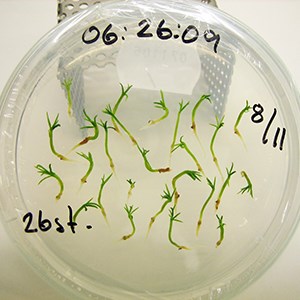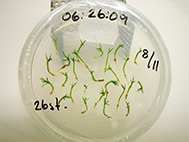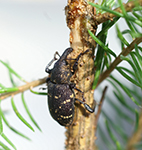Surprising discovery may be exploited to generate plants with enhanced resistance

Researchers at the Swedish University of Agricultural Sciences (SLU) and the Forestry Research Institute of Sweden (Skogforsk) have shown that Norway spruce plants produced through somatic embryogenesis, a clonal propagation method, are more resistant to pine weevil damage compared to conventionally cultivated seedlings. These differences in susceptibility to insect feeding are likely explained by the propagation method in itself, as plant defense mechanisms are known to be activated during the process. Thus, making this finding of broad interest for plant protection issues.
Propagation via somatic embryogenesis is a multiplication method that results in individuals that are genetically identical to the original material used for the process. In conifers, cells extracted from a seed embryo are used as the material to initiate multiplication. These cells are placed in a culture medium that contains different nutrients and high levels of plant hormones, which allows them to develop and mature into embryos that eventually become plants. This method allows rapid mass propagation of individuals that possess certain desired genetically determined morphological attributes. Thus, there is great interest in this method from the forestry sector in Sweden and the development of techniques for commercial production of somatic embryogenesis plants is ongoing.
"Our finding that plants multiplied via somatic embryogenesis are more resistant to pine weevil damage compared to conventionally cultivated seedlings, makes this method even more interesting specially from a plant protection perspective", says Dr. Adriana Puentes, first author of the study and researcher at SLU.
The finding that somatic embryogenesis appears to confer a previously unknown plant protection advantage is based on considerable evidence. Norway spruce plants propagated via somatic embryogenesis were compared with seedlings, originating from the same 50 half-sib families, in three large field trials set up by the Forestry Research Institute of Sweden in Southern Sweden. Originally, the aim of the field trials was to determine if somatic embryogenesis plants and seedlings differed in their establishment ability and growth properties.
The authors of the study used two of the field trials to examine pine weevil damage to plants, and expected to find differences between half-sib families – not that the propagation method in itself would affect how much insect damage the plants received.
"We were very surprised when our results showed that plants propagated via somatic embryogenesis had greater resistance against pine weevil damage compared to seedlings. We had to double-check that our results were in fact showing this difference in susceptibility to insect feeding between the two types of plants. Indeed, there was a clear difference and this was evident for both field trials", says Göran Nordlander, co-author of the study and professor at SLU.
Plants propagated via somatic embryogenesis had an average frequency of attack that was about 10% less compared to seedlings, and when attacked they received about 25% less pine weevil damage than seedlings. Effect sizes could vary depending on site and other factors, but the magnitude of differences is large enough to be of practical significance for forestry.
During the process of somatic embryogenesis, high levels of plant hormones are used. These plant hormones are naturally found in plants, but are required to be exogenously applied at high doses in order to initiate embryo development and maturation under in vitro conditions. In addition, these hormones are associated with the activation of plant stress-adaptation mechanisms, similar to those elicited when a plant is under attack by insects or pathogens. Thus, the authors of the study conclude that it is likely that somatic embryogenesis enhances plant defense levels and/or the ability of plants to respond to future attack as they have been previously exposed to stress, which results in less insect damage compared to seedlings.
"We think that enhanced plant defense levels and/or enhanced responses to future attack following somatic embryogenesis are a general feature associated with this method. This method is used for propagation of different crop and tree material, for example bananas, grapes, cacao as well as other coniferous trees such as larch. Thus, our finding opens up unexplored avenues of research within plant protection against insect pests. Our goal now is to determine the mechanisms and traits underlying the observed differences between somatic embryogenesis plants and seedlings", says Dr. Puentes.
The article was published in Frontiers in Plant Science.
More information
The article
Puentes, A., Högberg, K.-A., Björklund, N., & Nordlander, G. 2018. Novel avenues for plant protection: Plant propagation by somatic embryogenesis enhances resistance to insect feeding. Frontiers in Plant Science 9: 1553. https://doi.org/10.3389/fpls.2018.01553
Contact person
Adriana Puentes, Associate Senior Lecturer
Department of Ecology
Swedish University of Agricultural Sciences
Adriana.Puentes@slu.se
The other authors
Karl-Anders Högberg
Forestry Research Institute of Sweden (Skogforsk)
Karl-Anders.Hogberg@skogforsk.se
Niklas Björklund
Department of Ecology
Swedish University of Agricultural Sciences
Niklas.Bjorklund@slu.se
Göran Nordlander
Department of Ecology
Swedish University of Agricultural Sciences
Goran.Nordlander@slu.se
Press images
(May be published without charge in articles about this press release, please acknowledge the source)
Somatic embryos develop into identical individuals in vitro. Photo: Eva Persson
Pine weevil (Hylobius abietis) damaging a plant. Resin production is part of the plant's defense against insect feeding. Photo: Claes Hellqvist
Dr. Adriana Puentes, Associate Senior Lecturer, Dept. of Ecology, SLU. Her research is focused on how to utilize plants' anti-herbivore defenses within forest protection against insect pests. Photo: SLU


